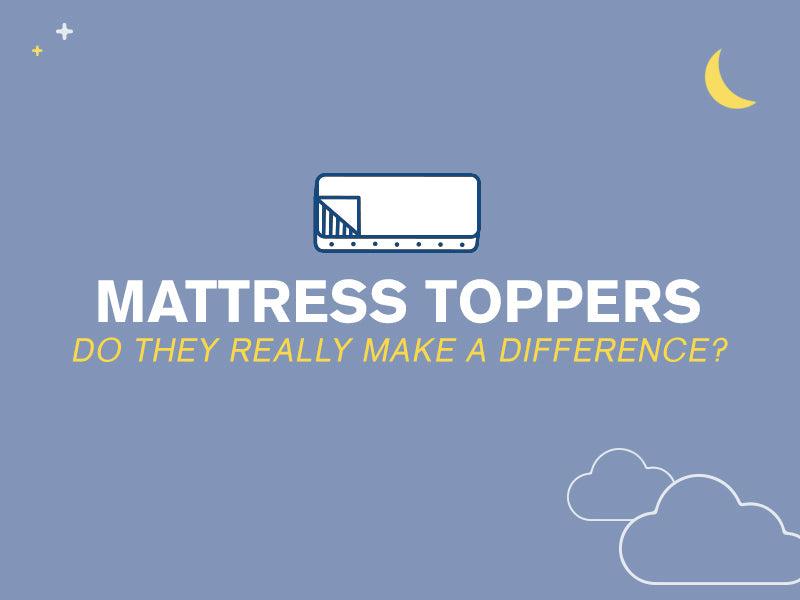Mattress Toppers: Do They Really Make a Difference?

Looking for a simple way to enhance your sleep experience without breaking the bank? Consider investing in a mattress topper.
In the quest for better sleep, many turn to mattress toppers as a potential solution. These versatile bedding accessories offer a cost-effective solution to improve the comfort and support of your mattress.
But amid the sea of options, it's natural to wonder: Do mattress toppers deliver on their promises? Let’s explore everything you need to know about mattress toppers, from what they are to how to choose the right one for your needs.
What is a mattress topper?
A mattress topper is a removable bedding layer that sits on top of your mattress, providing additional comfort and support. Made from various materials such as memory foam, latex, or down alternative, mattress toppers come in different thicknesses and densities to suit individual preferences. They can help alleviate pressure points, regulate temperature, and extend the lifespan of your mattress.
Benefits of mattress toppers
Enhanced Comfort
Mattress toppers add an extra layer of softness to your bed, offering a cozy embrace. Whether you choose memory foam, latex, or feather-filled options, these materials cradle your body for a more comfortable sleep.
Targeted Support
Mattress toppers address specific pressure points, providing relief and alleviating aches and pains for a more restful slumber. They soothe sore muscles and promote proper spinal alignment, enhancing overall sleep quality.
Extended Mattress Lifespan
By acting as a protective barrier, mattress toppers shield your mattress from spills, stains, and everyday wear and tear. This helps prolong the mattress's lifespan, ultimately saving you money in the long run.
What is the difference between a mattress pad and a mattress topper?
mattress pad, also known as a mattress protector or mattress cover, is a thin layer of material that is placed directly on top of a mattress to provide protection and enhance comfort. Unlike mattress toppers, which are thicker and primarily focus on adding cushioning and support, mattress pads serve primarily as a protective barrier between the sleeper and the mattress.
Mattress pads are typically made from materials such as cotton, polyester, or a blend of both. They are designed to safeguard the mattress from spills, stains, dust mites, allergens, and general wear and tear. Some mattress pads may also offer additional features such as waterproofing or hypoallergenic properties to cater to specific needs.
In addition to protection, mattress pads can also contribute to a more comfortable sleeping environment by providing a soft and smooth surface to lie on. However, their primary function is to maintain the cleanliness and longevity of the mattress by preventing damage from spills and other accidents.
How long does a mattress topper last?
The lifespan of a mattress topper depends on several factors, including the quality of the material, usage frequency, and maintenance. On average, a high-quality mattress topper can last anywhere from three to five years with proper care. Regularly rotating and flipping the topper can help distribute wear evenly and extend its longevity. Additionally, using a mattress protector can help protect the topper from spills, stains, and allergens, further prolonging its lifespan.
How to choose a mattress topper
When selecting a mattress topper, consider your sleep preferences, budget, and existing mattress. Here are some factors to keep in mind:
Material
Choose a material that aligns with your comfort and support needs. Memory foam toppers contour to your body shape, while latex toppers offer bounce and responsiveness. Down alternative toppers provide plush comfort without the allergens associated with down.
Thickness
The thickness of the topper determines its level of cushioning and support. Thicker toppers offer more cushioning and can help relieve pressure points, while thinner toppers provide a subtle layer of comfort.
Density
Opt for a density that suits your sleeping position and weight. Higher-density toppers offer firmer support and are ideal for heavier individuals or back and stomach sleepers. Lower-density toppers provide softer cushioning and are suitable for lighter individuals or side sleepers.
Breathability
Choose a breathable topper that promotes airflow and helps regulate temperature, especially if you tend to sleep hot.
Price
Set a budget and look for a mattress topper that offers the best value for your money without compromising on quality and comfort.
Do you need a mattress topper?
While mattress toppers are not essential, they can significantly enhance the comfort and support of your existing mattress. If your mattress is too firm, lacks cushioning, or shows signs of wear, a mattress topper can provide an affordable solution to improve your sleep quality. Additionally, if you're looking to customize your sleep surface without investing in a new mattress, a mattress topper offers a convenient and cost-effective option.
Before you decide on whether to invest in a mattress topper, weigh the pros and cons carefully. Consider factors such as your sleeping habits, mattress condition, and personal comfort preferences to determine if a mattress topper is right for you. With the right information at your fingertips, you can make an informed choice that will lead to better sleep and improved well-being.








